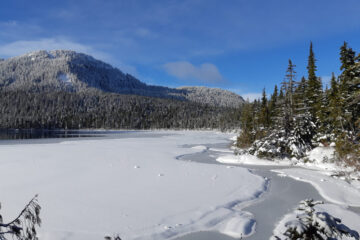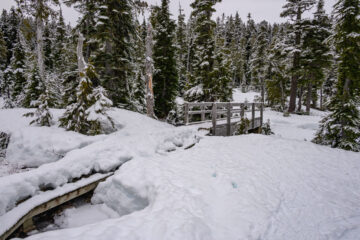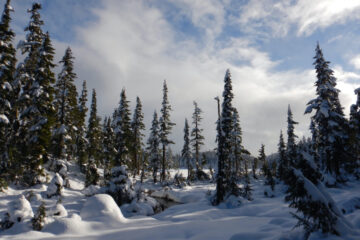Now that the Meadows have donned their winter mantle…
Paradise Meadows – December 5th [courtesy Glenn Gustafson] In this edition:
That was the Summer that was … 2022 has been a very different “summer” season. We had more or less 4 months of clear trails in the Subalpine, from late July to late October, roughly a month later than “normal” or at least in the past 4-5 years. While in most years we expect to have the Wilderness Centre open by mid June, 2022 saw a deeper than average snow-pack and a longer cool period through April and May, so that there was still snow on the boardwalks in Paradise Meadows in early July. And over in the Buttle area of the Park the winter storms wreaked havoc in the campsites and trails, with hundreds of fallen trees and limbs blocking access.
As a result, most hikers’ plans for early season expeditions were delayed, and although SWI was finally resuming its Summer Programme after a 2-year Covid hiatus, we did not start our Interpretive Walks in Paradise Meadows until July 10th. We postponed 2 hikes planned for mid July – Mt Elma still had over a foot of snow on the ridge, and the trail to Upper Myra Falls trail had too many fallen trees across the trail. However, by the later part of July a quick turn around in temperatures removed the snow, leaving very muddy trails and bugs to add to the atmosphere of “spring” hiking in the Subalpine. At least moisture-loving fungi abounded and the bird populations that depend on insects were thriving – only the bipedal visitors complained. By mid August, heat and lack of rain saw the start of “fire season” in BC. In the Park lightening strikes on the East side of the Golden Hinde and in the Wolf River watershed started fires that remained out of control for a couple of months, covering between the two around 600 hectares; even in mid November they were not entirely extinguished – smoke could still be seen and smelt across Buttle Lake around the Wolf River estuary on November 15th.
Nonetheless, no-one will complain about the magnificent Fall colours this year. By the end of September on the Plateau the various species of blueberries presented a magnificent display of deep red to salmon pin and purple.
At the end of October much needed moisture appeared – with the first snows blanketing the east side of the Park from about the 600m level, and enough depth to keep the early backcountry snow enthusiasts happy.
Allan Brooks ridge – mid November. [courtesy Judith Hilger]. On the west side of the Park, around Buttle the snow level started only above 1200m. and not in great abundance. The level of the lake was so low that one could walk across to some of the small islands at the north end of the lake and the deltas from Ralph River, Wolf River and Phillips Creek fan far out into the lake and the Narrows looks like a shallow stream.
Summer Season 2022 – Education and Research We were delighted to resume our summer programme of Interpretive Walks and Hikes, after a two-year hiatus. Veteran volunteers and directors acted as leaders in a variety of locations, on the Plateau and over in the Buttle area. Hike destinations included Mt Elma, Mariwood Lake and Arnica Lake, while the Walks focussed on our usual slate of the Park’s flora – Early Blooms in Paradise Meadows, Subalpine Trees, Lichens and Fall Berries. The organization of the walks and hikes was in the capable hands of one of our Canada Summer Jobs Students, Mateo Jaeckel, who had returned to work with SWI for a second year.
In terms of vegetation in the subalpine, the season was somewhat compressed – the succession of blooms in the Meadows, from the earliest Marsh Marigolds and Shooting Stars to the later Gentians and Ladies Tresses, after a delayed start, had run its course by early September. The moisture left by the snows encouraged spring snow-bank fungi and slime molds to flourish, but the sudden switch to hot and dry (admittedly preferred by hikers and climbers) altered conditions to the extent that by the time of our annual Mycology Workshop in September (17th and 18th) the range of species of fungi in the subalpine was somewhat limited – though there was just enough material to keep everyone on their toes. The Workshop included Presentations and Mushroom Identification sessions in the Ruth Masters Nature Hall, and forays out into the Meadows on the Saturday, followed by a hike into Divers Lake on the Sunday. And we were all thankful that for once there was no rain such as we have had in previous years for this event. For photos of the workshop see our website report of this event, with our usual team of experts – Shannon Berch, Juliet Pendray, Andy MacKinnon, Thom O’Dell, Kem Luther and photographer James Holkko. For an outline of the event and lots of photos, go to our Events Page – Past Events, and click there on 2022/09/17 – Mycology Workshop. While there were few Russulas, few Boletes, no Chanterelles and no Hedgehogs, there were a few fungi of note (though a little dehydrated) through the Fall, especially over in the Buttle area, so here are one or two of the more unusual species in terms of colour and morphology.
In addition to the Mycology Workshop, as we noted in the August Newsletter, SWI hosted Botany BC for its annual gathering of professional and amateur botanists and plant enthusiasts from British Columbia and areas beyond. The 2-day event in later July (22nd & 23rd) featured 4 guided hikes each day onto Forbidden Plateau (including Divers Lake, Mt Elma, MacKenzie Lake and Meadows, as well the west summit ridge of Mt Washington), led by local botanists/naturalists and our 2 CSJ students. We were happy to be able to accommodate this their first post-Covid in person gathering and in spite of the snow having only recently melted up on the Plateau the 35 plus participants were able to enjoy the stunning scenery of Park as a backdrop to fungi, lichens, slime molds, bryophytes and the occasional vascular plant in bloom.
In July and August our CSJ Research Assistants this year, Jack Bindernagel and Steven Hayward, completed surveys of lower elevation areas, complementing the work of our students in the two previous years. Thus, we have now added to the SWI Data Collection Project on iNaturalist data from the Bedwell Trail (Buttle to Bedwell Sound), Wolf River, Isardi Creek, as well as Divers/Rossiters Lakes and Mt Drabble. The total number of species for the Park now stands at 2123. Check here. Of note this year were additions to the number of species of lichens to bring the total number of species to 230 ( or which see the “Lichens of Strathcona Provincial Parks” project) made primarily by our two students and director L. Maingon. As mentioned in the August newsletter several new populations of a “species of concern”, the Old Growth Specklebelly lichen – Pseudocyphellaria rainierensis have been observed, adding to the one already known in the Park, in the Wolf River area. An article on this species in The Canadian Field Naturalist (Nov. 2022) may be accessed here A lichen listed as “endangered”, the Crab Eyed lichen – Acroscyphus sphaerophoroides, – found characteristically on the dead top of a conifer, was photographed this November by our CSJ student, Jack Bindernagel by executing a tricky climb and posted on the SWI iNaturalist project. Its extraordinary location suggests that birds who love to perch on such spikes must be the vector of the spores. It had been previously observed this summer in same area around Divers Lake by J. Straka, R. Mindell and L. Maingon (see right hand photo below).
Below are a few lichens from L. Maingon’s observations this season
And on Lichens, SWI is very pleased to announce that its “Basic Field Guide to the Lichens of Strathcona Provincial Park” is now at the Printers and should be available in early January, well in time for a Workshop on Lichens later in 2023. If you wish further information, please contact us at strathconawilderness@gmail.com The Canada Jay Project: Dan Strickland completed his 6th year studying Perisoreus canadensis in the Paradise Meadows area. The long winter and late spring of 2022 would appear to have caused a much lower success rate among the nesting populations of his study. You can read his preliminary report on our website’s Research Articles page, here. ************************* Thank-you, Volunteers! Each year we are ever grateful for the dedication of our volunteers, veteran and new, in helping SWI fulfil its mandate to Inspire awareness, appreciation and stewardship of the natural world through research, education and participation. This summer, when we could not unfortunately attract CSJ students to staff either the Wilderness Centre at Paradise Meadows or the “Hut” at Buttle Lake, we particularly appreciated the work of our volunteer staffers – without them we could not have had our information/education centres open for visitors. There were 7 volunteers at the SPWC and 7 at Buttle providing information and advice to visitors from all parts of the world. Special thanks must go to Judy vanBoven for her work at the Buttle Hut – more than half of the 50 days open were under her care. It was also a pleasure to welcome back those who have led walks and hikes in pre-Covid times. We scheduled a total of 15 Walks and Hike, thwarted only in the early part of the season by snow and windfall. And for our TrailRider Days showcasing Accessibility in the Park we welcomed the help of 4 experienced and 2 new volunteer sherpas.
Volunteer leaders & sherpas at Paradise Meadows For the third year in a row it has not been possible for us to hold a Volunteer Appreciation Evening in November as we did in pre-Covid times. However, since we know that the occasion provided an excellent opportunity for us to look back on the highlights of the season and as well as for our volunteers to meet one another, we are planning a special outdoors Appreciation Picnic next summer to make up for this gap in our annual calendar of events. Annual Report for 2022. Please find our Annual Report to BC Parks here for an overview of all our summer activities, and an account of visitor numbers /demographics at Paradise Meadows and Buttle Lake. ************************* Upcoming Events – 2023 Mark this date on your calendar: We will be bringing to the Stan Hagen Theatre the Winter Wildlands Alliance’s 18th Annual Backcountry Film Festival. Some of you may remember back to December 2019 what a stunning series of films this was – the last film festival we hosted before COVID. More details to following the New Year but meanwhile you can find out about it at https://winterwildlands.org/ ************************** ALBERT EDWARD – SNOW to SNOW in 3 MONTHS
|
Categories: Newsletter

 Paradise Meadows – late June
Paradise Meadows – late June
 Wolf River estuary – early October
Wolf River estuary – early October
 Near Kwai Lake – late September
Near Kwai Lake – late September

 Rainbow Island. South end of Buttle Lake – mid November
Rainbow Island. South end of Buttle Lake – mid November Phillips Creek
Phillips Creek

 Interpretive Walks in Paradise Meadows
Interpretive Walks in Paradise Meadows Interpretive Walks in Paradise Meadows
Interpretive Walks in Paradise Meadows

 Blue Stropharia
Blue Stropharia Orange Hydellum
Orange Hydellum

 Crab Eyed lichen [courtesy J. Bindernagel]
Crab Eyed lichen [courtesy J. Bindernagel] dead conifer spikes
dead conifer spikes Cabbage Lung
Cabbage Lung Golden Dot
Golden Dot Mountain Bootstrap
Mountain Bootstrap Toy Soldiers
Toy Soldiers 

 Judy at the Buttle Hut
Judy at the Buttle Hut







